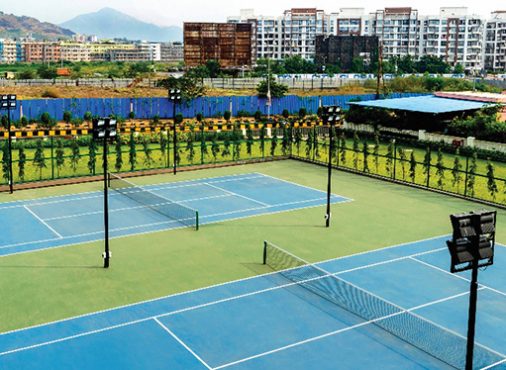A comprehensive knowledge and understanding of carpet area, built-up area, and super built-up area can guide potential homebuyers to informed decisions. Brokers, builders, and developers frequently use common real estate jargon like carpet area, RERA carpet area, built-up area, and super built-up area when speaking to customers, which makes defining these terms even more important.
In this article, we have simplified these terms by stating what built-up area means, the difference between carpet area and built-up area, their significance, and methods to calculate them.
What is Carpet Area, Built-Up Area, Super Built-Up Area?
Carpet Area
A carpet area represents the actual usable space within an apartment, excluding the wall thickness, or an area that a carpet can cover. It refers to the space within the internal walls that includes the living room, bedrooms, bathrooms, kitchen, balconies, and also internal staircases, if any, within the apartment.
What it excludes is the external and internal wall thickness, lift lobby, corridors, terraces, utility ducts, and common areas. Carpet area is calculated by measuring only the internal dimensions of a property.
RERA Carpet Area
According to the Real Estate Regulatory Authority (RERA) Act 2016, RERA carpet area is the net usable floor area of a property or apartment, including the area covered by internal walls and excluding the common areas, exclusive balconies, and terrace areas attached to the property for personal use.
Note: The carpet area pre-construction may not be the same post-construction. There is always a chance of an increase or decrease of 3% in the carpet area, which is usually adjusted while finalizing the final price. If there is a decrease, you will receive a refund. However, an increase of over 3% is not permitted, as per RERA.
![]()
Built-Up Area
The built-up area of an apartment is the carpet area plus the area of the internal and external walls. It also includes other areas like exclusive balconies, terraces, and an internal staircase in case of a duplex apartment. Built-up area is always higher than carpet area.
Super Built-Up Area
The super built-up area is the built-up area of the property plus common areas, amenities, and shared facilities in the housing project.
These facilities may include staircases, lift shafts, gardens, lobbies, pools, gyms, and clubhouses. It refers to the total area a buyer pays for – not just personal space but also a proportionate share of the common spaces.
Difference Between Carpet Area and Built-Up Area
| Feature | Carpet Area | Built-Up Area |
| Definition | The usable floor area excluding the thickness of external walls and common areas. | The total area within the apartment including the thickness of the external walls, balconies, and other usable areas within the apartment. |
| Alternate Definition | The area you can lay a carpet on. | The total area of your apartment, excluding common areas like hallways and lobbies. |
| Includes | Bedrooms, living room, kitchen, bathrooms, internal walls, and balconies (sometimes). | All of the above plus the thickness of external walls, balconies (always), and any exclusive-use corridors. |
| Excludes | Thickness of external walls, common areas like hallways, lobbies, and amenities like swimming pools. | Common areas like hallways, lobbies, and amenities like swimming pools. |
| Cost per sq. ft. | Generally, the lowest cost per sq. ft. | Generally, higher than the carpet area cost per sq. ft. |
| Size Comparison | Always smaller than the built- up area. | Always larger than the carpet area. |
Legal Implications of Carpet Area, Built-Up Area, Super Built-Up Area
Carpet Area – Compliance with RERA regulations is mandatory for developers, and failure to adhere to these guidelines can result in penalties. Homebuyers benefit from the assurance that the disclosed carpet area aligns with the regulatory standards, improving trust in the real estate market.
Built-Up Area – The built-up area is vital to legal documentation and agreements. Homebuyers should be aware of this metric to ensure that they are paying for the space as per the mutually agreed-upon terms and conditions.
Super Built-Up – Most regions have regulations that disclose the super built-up area which ensures transparency and legal compliance.
How Are Carpet Area, Built-Up Area, and Super Built-Up Area Calculated?
1. Formula to calculate carpet area
Carpet area = (bedrooms + living room + kitchen + toilets + balconies) – the thickness of internal walls
The carpet area of an apartment is usually between 70% to 90% of its built-up area.
2. Formula to calculate RERA carpet area
RERA carpet area = (net usable area of the apartment + area of internal walls) – (area of external walls, exclusive terraces, and balconies)
Rustomjee Urbania, located in Thane West, presents thoughtfully designed residences featuring a 2BHK option with a RERA carpet area ranging from 633 to 715 sq. ft. and a spacious 3BHK variant spanning 880 to 1076 sq. ft. Explore the perfect blend of comfort and style in these carefully crafted living spaces.
3. Formula to calculate the built-up area
Built-up area = carpet area + area of walls + area of balconies and terraces
The carpet area of an apartment is usually between 70% to 90% of its built-up area.
The built-up area is usually 15-30% of the carpet area.
For example, in one of the 2BHK Rustomjee Urbania flats, Wing G, the carpet area is 647 sq. ft, and the area under the deck/balcony/service slab is 204 sq. ft.
Therefore, Built-up area = 715+132 = 851 sq.ft
In another example of the 2BHK Rustomjee Urbania Flats, Wing J, the carpet area is 640 sq. ft, and the area under the deck/balcony/service slab is 222 sq. ft
Therefore, Built-up area = 640+222 = 862 sq. ft
![]()
A View of Rustomjee Urbania
1. Formula to calculate the super built-up area
Super built-up area = Built-up area + proportionate common area
Or
Super built-up area = Carpet area*(1 – loading factor)
2. What Is Loading Factor?
The difference in area between the super built-up area and the carpet area of the apartment is the loading factor. This is used to add the common facilities that are not exclusive to you, like elevators, lobbies, parking, etc.
For example, if the loading factor is 1.5, it indicates that your carpet area has been increased by 50% by the builder.
3. How Do You Calculate the Loading Factor?
Loading factor = Super built-up area – carpet area
Note: The additional load, varying from 15% to 50%, depends on the builder and the exact location. In metropolitan areas, the loading factor might hover around 20-25% or possibly more.
Significance of Carpet Area, Built-Up Area, and Super Built-Up Area for Homebuyers
![]()
RERA Carpet Area
- Accurate Measurement – RERA mandates accurate calculation of the carpet area and provides complete disclosure of actual usable space, offering homebuyers a clear understanding of the area they are investing in.
- Optimum Space Utilisation – Buyers understand the actual area of usable space within the apartment and can plan their requirements accordingly.
- Fair pricing – RERA ensures that homebuyers only pay for the saleable area. The accurate details help buyers have an exact estimate of the property value.
- Transparency – RERA regulations mandate developers to provide carpet area and other vital details about residential properties to maintain transparency with homebuyers.
Built-Up Area
- Comparing Property Pricing – Real-estate properties are often quoted based on built-up areas. Homebuyers can evaluate the cost per square foot of the entire built-up space, providing a basis for comparing different properties and their respective values.
- Resale Value – When it comes to selling property in the future, having enough knowledge about the built-up area is essential. It enables sellers to accurately communicate the property’s size to potential buyers, influencing the resale value positively.
Super Built-Up Area
- Property Rates and Transparency – The total area you’re charged for, known as the super built-up area, sets the basis of pricing and cost calculations. This not only covers your unit but also shared areas like lobbies and amenities.
- Includes Shared Facilities – The super built-up area considers everyone’s share of common spaces, spreading the cost of shared facilities among buyers.
- Monetary Considerations – Real estate investors often look at the super-built-up area to figure out rent or resale value. Including shared facilities makes a property more attractive for potential renting or selling purposes.
Conclusion
![]()
Rustomjee Urbania
Evaluating the size of apartments with a clear understanding of these key terms can simplify the entire buying process for customers. The insights into areas, pricing, and property values can empower you with factual information and help you make an informed decision. It can also help you negotiate fair deals with property managers when buying or selling a property.
If you’re looking for assistance in buying or selling properties in the real estate market, get in touch with Rustomjee today. Our professionals will help you find the perfect home that meets all your requirements. We are a name that invokes trust in the real estate space for our design, transparency, and the quality of life at our properties.
FAQs
1. Why is it essential to understand the difference between carpet area and built-up area when buying a Rustomjee property?
Understanding the difference between carpet area and built-up area helps buyers make informed decisions about the value they are getting for their investment. It also helps them compare properties accurately and gives them a clear idea of the space.
2. Are terms like carpet area, built-up area and super built-up area standardised globally, or do they vary from region to region?
While the concepts are generally consistent, the exact definitions and measurements may vary from one region to another and even between different developers within the same region. Buyers must clarify these details before finalizing any property transactions.
3. What factors should be considered while buying a Rustomjee property?
While carpet area provides an accurate measure of usable space, built-up area, and super built-up area are more relevant for pricing and legal documentation. Buyers should review all these metrics to make informed decisions based on their space requirements and budget constraints.
4. Does Rustomjee provide clarity in terms of carpet area and built-up area?
Yes, Rustomjee clearly distinguishes and mentions the carpet area and other areas separately for every flat.
5. How can homebuyers verify the accuracy of the RERA Carpet Area provided by Rustomjee?
Homebuyers can check and verify the details on the official website, including the RERA carpet area.
6. How does understanding carpet area, built-up area, and super built-up area affect my investment in Rustomjee Urbania?
Understanding the breakdown of various areas in your apartment is crucial to determining the actual living space you’ll be getting versus the total space you’re paying for. This helps in making a fair comparison of value for money. Two apartments with similar super built-up areas might have vastly different carpet areas, which can significantly influence your decision. Having access to this information ensures transparency in agreements, prevents disputes, and assists in the accurate calculation of property taxes and resale value.
7. What considerations should I keep in mind regarding carpet area, built-up area, and super built-up area when purchasing a property in Rustomjee Urbania?
Evaluate the proportion of carpet area to built-up and super built-up area to understand the space utilisation.
Analyse the per sq. ft cost and consider factors like amenities, location, and future potential.
Consider how the distribution of these areas aligns with your lifestyle needs and future changes. For instance, a larger carpet area may be preferable if you prioritise living space, while a well-designed super built-up area with amenities might suit those who value facilities and social interactions.
Ensure that all agreements and contracts clearly specify the definitions and measurements of carpet area, built-up area, and super built-up area according to Rustomjee Urbania standards.







